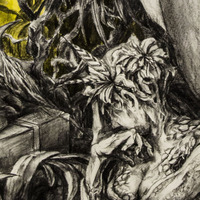OLD YOUNG / コヤマナット、松本茜、森島里香

OLD YOUNGは、田名網敬一先生の指導の下、京都造形芸術大学の修士課程で学ぶ3名による展示である。河合隼雄の「影の現象学」に基づいた影の探求や、夢日記を書くという田名網先生のユニークな課題のおかげで、私たちの想像力が刺激され、制作を進めることができた。一年間の制作活動の最終目標が、このタンバリンギャラリーでの展示である。大学という守られた環境から離れ、私たちにとって初めての東京での展示に挑むために、今まで以上の挑戦が必要であった。
【狭間からのノート】
大友克洋によるアニメ・漫画の名作、アキラにはナンバーズという「年老いた幼児」が登場する。これは幼児化する文化と同時に高齢化する人口の問題に直面する日本の象徴と捉えることができる。新しいものと古いもの、伝統と近代の間の矛盾は谷崎潤一郎の「陰影礼賛」で皮肉たっぷりに扱われている。谷崎は日本の伝統的な美意識を陰の世界と結びつけ、西洋の美学は光につながるという不思議なテーゼを提示した。
この退化と進化が重なりあう奇妙な二重性は、各世代の経験に明確なずれを起こしてきた。
昨年から日本に留学し、田名網敬一先生の授業を受けてから、このずれを直接に感じ取ることができた。先生の生まれは戦前までさかのぼるが、彼の精神とエネルギーは驚くほど新鮮で前向きで、ナイーブとも言える。戦争を生き延びた田名網先生のカリスマは、死から紙一重しか離れていない生の活力からくるのではないか。先生のアトリエを訪れた時、机の奥の壁に大きな、永遠に若いマリリン・モンローの顔が飾ってあった。西洋と東洋、伝統と現代が混じり合った魔界の様な空間だった。
それに比べて、毎日大学で私の周りにいる学生たちには、彼らの年齢を裏切る疲れと保守性が見える。ドイツの哲学者ピーター・スローターダイクによると、人類は二十世紀の猛烈な変化の後、結局進化への試みが失敗したため、二十一世紀は保守的な世紀になると予言している。面白いことに、この展示に参加する他の二人は、新しいものではなく古いものに強く傾倒している。松本さんは製作中落語を聞くのが好きで、読書は谷崎の他萩原朔太郎等、昔の作家を好む。彼女の作品にも時間の流れで崩れてゆく女性の体が常に登場する。また森島さんのコラージュの素材はすべて60や70や80年代、彼女が実際に経験していない時代のメディアから集め、新たに再構築していく。これは失望の時代からの脱却、そして田名網先生に代表される希望と革命の時代に対するノスタルジーではないか。実際は古いが精神的に新鮮なもの、精神的には古くても実際は新しいものの間、先生が若くて生徒が老けているように見えるこの不思議な空間で、本展示の作品が完成した。
しかし私は外から来た人として、この複雑な状況から微妙に離れた距離を感じる。中質的で孤立したどこでもない空間、ある意味、私が以前住んでいたオーストラリアでは問題となっている難民収容所と対比できる。だが世界の不平等の犠牲となった人たちの収容所の檻と違って、私を囲む壁は透明で柔軟であり、その壁のおかげで私自身も不可視になっていて、他人と別の規則で生きることができる。潜水艦の潜望鏡から外を見る乗組員のように、私は一時的な観察者であるだけで、この古くもあり新しくもある瞬間、ここでもよそでもない瞬間を未完成な描写だけで記録することしかできない。 コヤマ・ナット
【Notes from In-Between】
In Otomo Katsuhiro's anime and manga masterpiece Akira, there appears hybrid entities that are 'old infants', who could be seen as symbols of the simultaneous infantilisation of Japanese culture and the increasing average age of the population which threatens to further cripple the economy of this nation in future years. On another level, the paradox of old and young, ancient and modern in Japan is ironically described by Tanizaki Junichiro in his literary prank In Praise of Shadows, where Japanese aesthetic traditions are aligned with the world of shadows and Western notions of beauty associated with illumination.
What has often aroused foreign curiosity for Japan is this seemingly paradoxical duality, the overlap of regression and progression creating stark gaps between the experiences of each generation.
Having studied under Tanaami
Keiichi since my arrival in Japan as a research student in April last year, I
have felt these contradictions between age and youth first hand. Despite his
physical age, Tanaami still possesses an incredibly youthful, optimistic, even
naive energy and spirit. I have read autobiographies by Japanese such as Osamu
Tezuka and Masao Miyoshi who like Tanaami survived the bleak years of the war,
and they recount an indescribable euphoria when they realised they had escaped
death that seems to have fuelled them for the rest of their lives. This may be
related to the reason for Tanaami's charisma, perhaps of charisma in general.
The vibrancy life takes on when it has come within a hair's width of death. I
found it most symbolic that I saw a large, iconic photo of Marilyn Monroe,
frozen in a state of permanent youth, stuck above Tanaami's work desk when I
had the chance to visit his studio.
In contrast, when I look around at the students who surround me at the university campus each day, I sense a fatigue and conservatism in many of them that belies their age. Interestingly, the two other students in this exhibition demonstrate a strong inclination towards culture from the past rather than the new. Matsumoto enjoys listening to Rakugo while she works, and as well as Tanizaki reads other writers of the past such as Hagiwara Sakutaro. At the same time, her work is preoccupied with the physical decay brought about by the passing of time. The material for Morishima's collages seems to be almost exclusively from the 60s, 70s and 80s, decades which she could have no personal recollection of. Is this not an attempted escapism from this age of cynicism, and nostalgia for the era of hope and revolution represented by the likes of Tanaami? It is between these two extremes, the physically old and the spiritually young, the physically young and the spiritually old, where the work presented in this exhibition has been formed.
Despite having Japanese ancestry, as a foreigner I cannot help but feel one step removed from the complexities of this situation. I feel like I occupy a neutral, detached nowhere space, which could perhaps be compared to the immigration detention centres that have aroused so much controversy in my former nation of Australia in its recent history. Unlike these prisons for the victims of global inequality however, the walls that surround me in this nowhere space are invisible, while at the same time, because of the cultural gaps that separate me from this society, it is I myself who is in a certain sense invisible to those around me. Like the crew looking through the periscope of a submarine, I feel I am merely a temporary observer that can only record half-formed images of these moments here that are simultaneously both old and young, neither here nor there. - Nat Koyama


